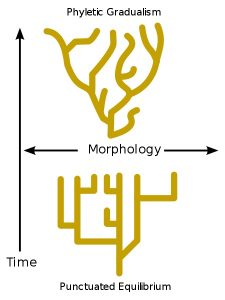Gradualism Definition
In biology, gradualism is a theory that assumes large morphological changes in organisms occur via a number of smaller step over a number of years. The theory can be contrasted to punctuated equilibrium, which suggests that species remain relatively constant over time, until drastic events force quick evolutionary changes. Proponents of gradualism fall on a spectrum. Those who support phyletic gradualism endorse a slow, steady change through time which leads to drastic morphological changes. Punctuated gradualism, on the other side of the spectrum, suggests that the process is both gradual, and punctuated with drastic events.
Types of Gradualism
Phyletic Gradualism
Seen in the top of the image below, phyletic gradualism suggests that the changes in animals occur steadily over time. The sloping lines suggest that the change in morphology shown happened slowly, through many generations of animals. While this image is entirely hypothetical, it could represent any group of animals.
For instance, if the two trees both represent hypothetical relationships between domestic dogs, the cladogram of phyletic gradualism on the top would tell a story of slow changes over time. At the bottom of the tree would be the wolf, or the closest ancestral relative. As the tree progresses upward, more generations of dog-like creatures were being born. Some of the lines, unfit for their environment, died out along the way. However, many lines made it to present day (the top of the tree). One the left might be the smallest dogs, such as the Dachshund and Rat Terrier. On the other side would be dogs which are now morphologically larger than wolves, such as Great Danes and Irish Wolf Hounds.
Gradualism suggests specifically that the changes in these animals came in small increments, over time. To get to a Dachshund, gradualism suggests, one must first breed a smaller and longer wolf. Every generation, the wolves get smaller and longer. Eventually, after many generations, you have a dog which no longer resembles a wolf at all. The same would occur in the other direction, with the animals slowly getting larger over time. Thus, the theory of gradualism proposes that changes occur in many small steps, over time. While this is an interesting theory, and probably true to some extent, fossil record analysis have shown that at least some organisms experience much more rapid change.
Punctuated gradualism
Punctuated equilibrium, seen in the lower half of the image above, suggests that instead of slow changes over time, change happens drastically and almost immediately. While several fossil records and studies of microevolution have shown that drastic change can happen quickly, it might not get the whole picture. Punctuated gradualism is a step between the two.
In punctuated gradualism, it is assumed that genetic changes are amassed and exchanged in a population regularly. In other words, their DNA gradually changes. However, a large body of fossil evidence suggests that over time, these changes cause relatively little morphological change. Many species seem to hold static for a long time, only to change relatively quickly. The gradualism, in this case, comes from the mutations and genetic rearrangements which happen during the static period.
In an unpredictable manner, environmental changes can change the expression of an organism’s genetics. At times when there are large environmental upheavals, these “punctuated” change events can occur. Some organisms within a group, now able to utilize their genetic advantage, break off from the pack and forge their own evolutionary history. Punctuated gradualism is a middle-of-the-road approach to understanding evolutionary change.
Gradualism in the Environment
Gradualism, as a theory in general, started in geology. Scientists studying rock formations, such as the Grand Canyon, made the observation that the river within the canyon was carrying minute amounts of sediment from the canyon out to sea. While these deposits were small each year, over eons the Grand Canyon was carved.
Using the theory of gradualism, scientists can understand and infer more about the abiotic factors affecting biology. For example, every year the tectonic plates move a fraction of an inch. While this movement is negligible in our lifetimes (besides causing earthquakes), the movement of the continents over time has serious consequences for evolution as a whole. Measuring the movements of the continents, scientists have been able to model the Earth through the evolutionary history of organism. This not only gives us a greater understanding of the world around us, but shows us how seemingly different animals were once populating a mega-continent called Pangea.
Quiz
References
- Brusca, R. C., & Brusca, G. J. (2003). Invertebrates. Sunderland, MA: Sinauer Associates, Inc.
- Hartwell, L. H., Hood, L., Goldberg, M. L., Reynolds, A. E., & Silver, L. M. (2011). Genetics: From Genes to Genomes. Boston: McGraw Hill.
- Pough, F. H., Janis, C. M., & Heiser, J. B. (2009). Vertebrate Life. Boston: Pearson Benjamin Cummings.

